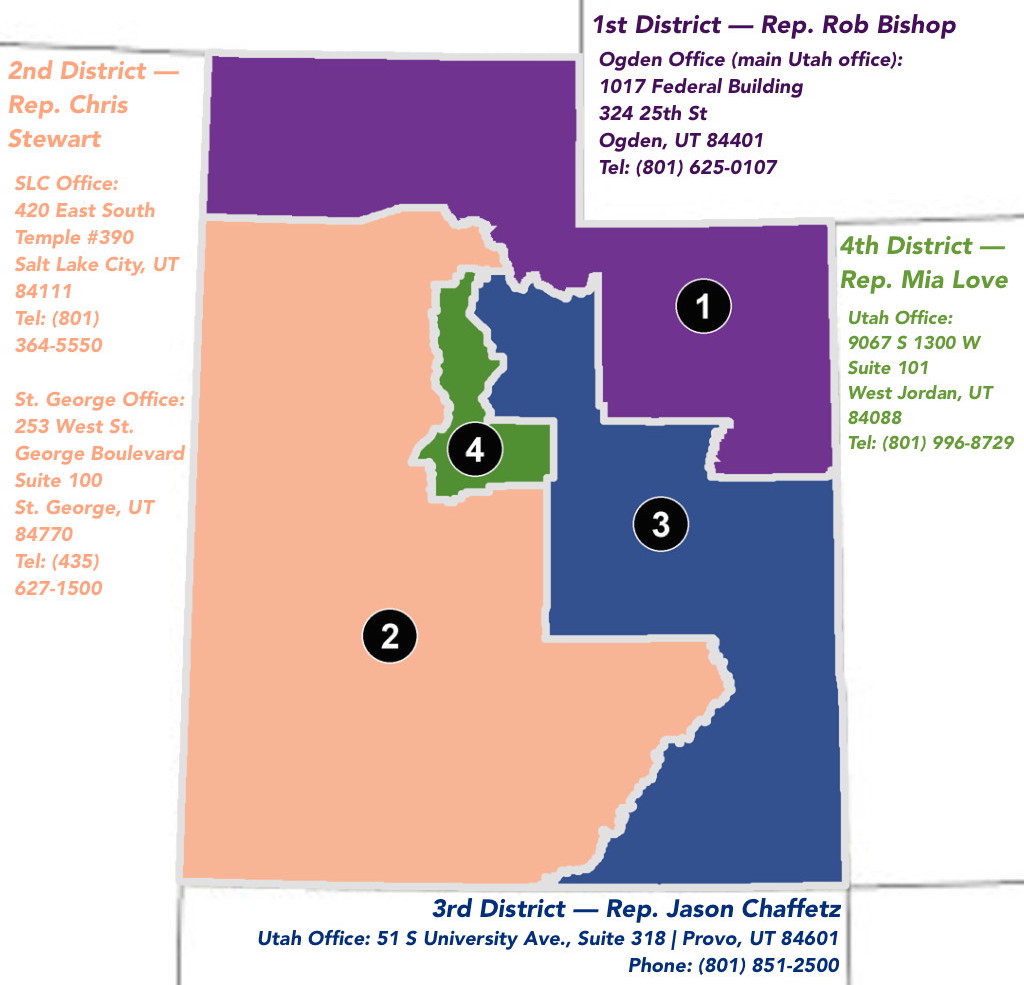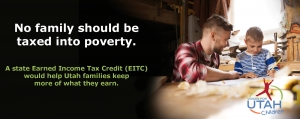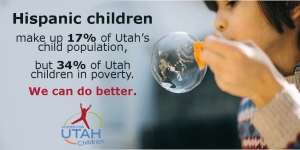Poverty
Creating a Targeted State Earned Income Tax Credit (EITC)
The federal Earned Income Tax Credit (EITC) lifts 60,000 Utahns out of poverty each year, half of them children, by letting low-income families keep more of what they earn.
EITC helps working families make ends meet.
EITC keeps families working.
EITC reduces poverty, especially among children.
EITC put $426 mil. back into Utah’s economy in 2017.
A state EITC targeted to families living in intergenerational poverty (IGP) will give a boost to the 25,000 working families who qualify for the federal EITC and file state taxes.
It will ensure that eligible working families receive 10% of federal EITC - up to $640 depending on income and number of children.
A state EITC may increase participation in the federal EITC. Only 75% of tax filers take advantage of the federal EITC
No bureaucracy or staff to administer.
FISCAL IMPACT
$6 million from General Fund which is a small portion of the over $25 million in state and local taxes paid every year by these working families.
Simply put, 58,820 children identified as living in intergenerational poverty amounts to $102 per child.
STATES WITH A STATE EITC
Twenty-nine states across the nation and political spectrum have created state EITCs.
EITC has strong bipartisan support
“… the proposed EITC helps people who are ready and able to help themselves escape intergenerational poverty through work…It is both sound economic policy and prudent welfare policy… It is good for those in poverty, good for the economy, and good for taxpayers as well.” Sutherland Institute
“I know of no public policy innovation over the past 30 years to help low-income individuals that has as much promise as Utah’s intergenerational poverty work. When combined with an EITC, Utah will be able to show the nation how public policies that are targeted, incentivize work, are fiscally constrained and include measurable outcomes are the best way to help families and children with great need.”
Natalie Gochnour
Associate Dean, David Eccles School of Business,
University of Utah, Deseret News column, March 1, 2018
For 30 years now, Voices for Utah Children has called on our state, federal and local leaders to put children’s needs first. But the work is not done. The children of 30 years ago now have children of their own. Too many of these children are growing up in poverty, without access to healthcare or quality educational opportunities.
How can you be involved?
Make a tax-deductible donation to Voices for Utah Children—or join our Network with a monthly donation of $20 or more. Network membership includes complimentary admission to Network events with food, socializing, and opportunity to meet child advocacy experts. And don't forget to join our listserv to stay informed!
We look forward to the future of Voices for Utah Children and we hope you will be a part of our next 30 years.
Special thanks to American Express, our "Making a Difference All Year Long" sponsor. 
Tell Senator Hatch Not to Repeal the ACA Without Replacing It #ProtectOurCare #CareNotChaos
Does your family benefit from the ACA, Medicaid or CHIP health coverage? We want to talk to you.
Help us raise our voices for Utah children. #GivingTuesday
Tell Congress to Support the Child Care and Development Block Grant
 The Child Care and Development Block Grant (CCDBG) is the primary source of federal funding to help increase the health, safety, and quality of child care and make child care assistance a more stable support for families. Quality child care enables parents to work or go to school while providing their children with safe and enriching environments where they can learn and thrive. Because of the CCDBG, thousands of hardworking Utah families have access to high-quality child care for their kids.
The Child Care and Development Block Grant (CCDBG) is the primary source of federal funding to help increase the health, safety, and quality of child care and make child care assistance a more stable support for families. Quality child care enables parents to work or go to school while providing their children with safe and enriching environments where they can learn and thrive. Because of the CCDBG, thousands of hardworking Utah families have access to high-quality child care for their kids.
Congress is currently considering an Appropriations Bill that would increase funding for the CCDBG. We do not know as of today whether Congress will complete a bill this session, but what we do know is that we need an increase of $1.2 billion in CCDBG funds in order to ensure that no additional children lose child care assistance. We also know that Congress is working right now to decide on how to proceed with the Appropriations Bill.
It is absolutely critical to keep the importance of increasing funding for child care before the Congress as we move forward, and to do that we need your help. So today we are asking you to please contact your representative in Congress to ask that the 2017 Appropriations Bill include a $1.2 billion increase for the Child Care and Development Block Grant.
For 30 years now, Voices for Utah Children has called on our state, federal and local leaders to put children’s needs first. But the work is not done. The children of 30 years ago now have children of their own. Too many of these children are growing up in poverty, without access to healthcare or quality educational opportunities.
How can you be involved?
Make a tax-deductible donation to Voices for Utah Children—or join our Network with a monthly donation of $20 or more. Network membership includes complimentary admission to Network events with food, socializing, and opportunity to meet child advocacy experts. And don't forget to join our listserv to stay informed!
We look forward to the future of Voices for Utah Children and we hope you will be a part of our next 30 years.
Special thanks to American Express, our "Making a Difference All Year Long" sponsor. 
How are kids doing in my county?
New local data for each county in Utah are now available at the Voices for Utah Children website. Each county-level profile includes child demographics and measures of child-wellbeing related to education, health and economics.
Here are just some of the questions you can answer with the new data:
- What is the average student/teacher ratio at local schools?
- What percent of kids are chronically absent from local schools?
- How many children were victims of abuse in my county?
- What is the children’s health insurance rate in my county?
- How many local kids are living in poverty?
Check it out here:
Kids Count County Data Sheets
For 30 years now, Voices for Utah Children has called on our state, federal and local leaders to put children’s needs first. But the work is not done. The children of 30 years ago now have children of their own. Too many of these children are growing up in poverty, without access to healthcare or quality educational opportunities.
How can you be involved?
Make a tax-deductible donation to Voices for Utah Children—or join our Network with a monthly donation of $20 or more. Network membership includes complimentary admission to Network events with food, socializing, and opportunity to meet child advocacy experts. And don't forget to join our listserv to stay informed!
We look forward to the future of Voices for Utah Children and we hope you will be a part of our next 30 years.
Special thanks to American Express, our "Making a Difference All Year Long" sponsor. 
Recent Census data show that Utah has made some improvements when it comes to reducing child poverty, but Utah Hispanic or Latino children are still disproportionately experiencing poverty, compared to their White peers.
Looking at the overall poverty rates, Utah children fare better than the rest of the United State, the so-called “Utah advantage”. But the gap between White children and Hispanic children in Utah is alarming: 25% of Hispanic children live in poverty, compared to 9% of White children.
The poverty rate for Utah Hispanic children declined in 2015, while the rate for Utah White children remained relatively stagnant. The poverty rate for Utah children overall stayed at 13%. Although the decline in poverty rates for Hispanic children is encouraging, the gap between White children and Hispanic children is still too wide.
Utah’s 2015 child poverty data underscore the need for an equity review of our programs and policies: Why are some racial and ethnic groups making progress, while other groups stagnate? How do we close the economic divide between Hispanic and White children?
Going forward, politicians and decision-makers need to look at the impact our policies have on children of all racial and ethnic groups, so we can strengthen what’s working and re-evaluate what’s not.
For more information, see Income and Poverty in the United States: 2015.
A closer look at the numbers: Why only White and Hispanic children?
We are sharing child poverty data from the Census Bureau’s American Community Survey. For child poverty rates in Utah, unless multiple years of data are aggregated, statistically-significant Census findings are only available for the following racial and ethnic categories: non-Hispanic White, Hispanic or Latino, and 2 or more races. Unfortunately we do not have data available for all groups of children in our state. As recent Utah Department of Health Office of Heath Disparities reports highlight, disparities affect all children of color in our state. We need more child-specific data, disaggregated by race and ethnicity, so we can understand how policy decisions are affecting all groups of children in Utah.
For 30 years now, Voices for Utah Children has called on our state, federal and local leaders to put children’s needs first. But the work is not done. The children of 30 years ago now have children of their own. Too many of these children are growing up in poverty, without access to healthcare or quality educational opportunities.
How can you be involved?
Make a tax-deductible donation to Voices for Utah Children—or join our Network with a monthly donation of $20 or more. Network membership includes complimentary admission to Network events with food, socializing, and opportunity to meet child advocacy experts. And don't forget to join our listserv to stay informed!
We look forward to the future of Voices for Utah Children and we hope you will be a part of our next 30 years.
Special thanks to American Express, our "Making a Difference All Year Long" sponsor. 









